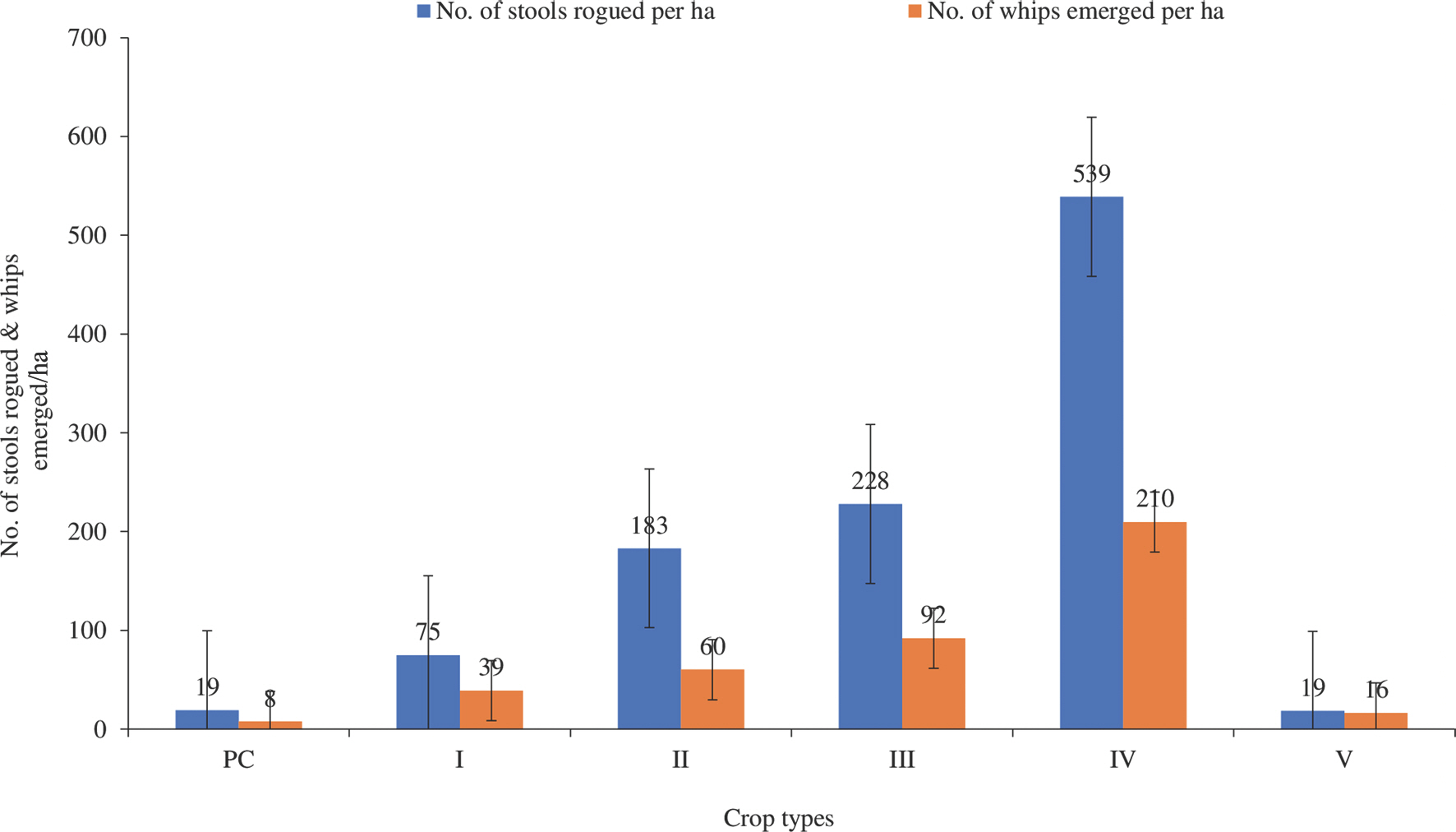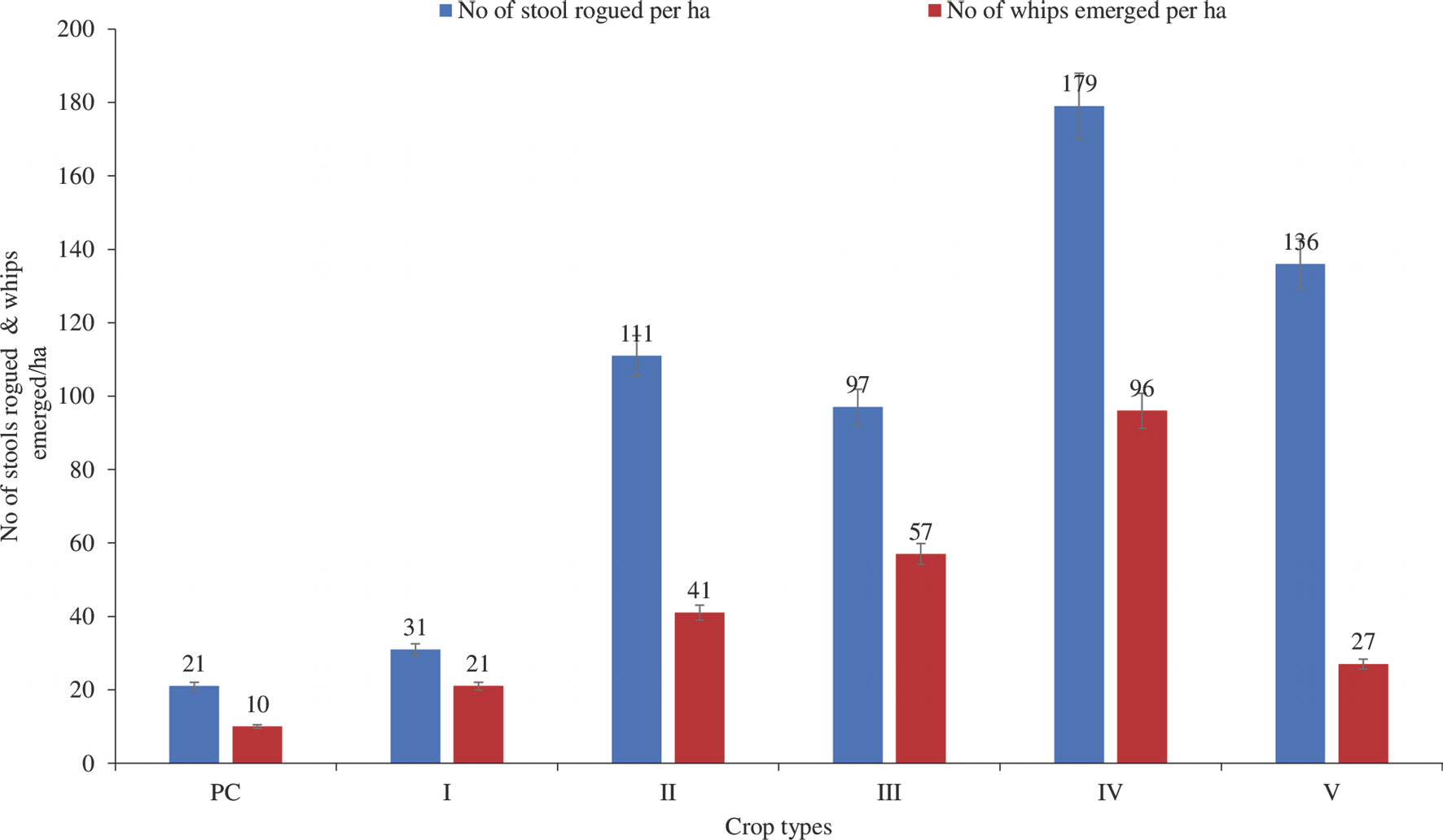Abera, T., Firehun, Y. and Solomon, B. 2009. Review of sugarcane protection research in Ethiopia. In: Increasing crop production through improved plant protection, Vol. 2: ed. by A. Tadesse, pp. 409-447. Plant Protection Society of Ethiopia, Addis Ababa, Ethiopia.
Abera, T. and Teklu, B. 2005. Survey of sugarcane disease in the Ethiopia sugarcane plantation. Ethiopian Sugar Industry Support Center Research and Training Service, Wonji, Ethiopia.
Abera, T. and Tesfaye, H. M. 2001. Review of sugarcane research in Ethiopia: II. Protection (1970-1998). Ethiopian Sugar Industry Support Center Research and Training Service, Wonji, Ethiopia.
Ambachew, D. and Firehun, Y. 2012. Cane sugar productivity potential in Ethiopia: The role and direction of research. Sugar Industry Support Center Research and Training, Wonji, Ethiopia. pp. 45 pp.
Bhuiyan, S. A., Croft, B. J. and Cox, M. C. 2009. Survival of sugarcane smut teliospores under south east Queensland conditions. Proc. Aust. Soc. Sugar Cane Technol. 31: 135-144.
Bhuiyan, S. A., Croft, B. J., Cox, M. C. and Bade, G. 2010. Varietal resistance of sugarcane to natural infection of smut-preliminary results. Proc. Aust. Soc. Sugar Cane Technol. 32: 355-365.
Binns, M. R., Nyrop, J. P. and van der Werf, W. 2000. Sampling and Monitoring in Crop Protection: The Theoretical Basis for Developing Practical Decision Guides. CABI Publishing, New York, NY, USA.
Braithwaite, K. S., Bakkeren, G., Croft, B. J. and Brumbley, S. M. 2008. Genetic variation in a worldwide collection of the sugarcane smut fungus Ustilago scitaminea. Proc. Aust. Soc. Sugar Cane Technol. 26: 24-35.
Cammarano, D., Ceccarelli, S., Grando, S., Romagosa, I., Benbelkacem, A., Akar, T. et al. 2019. The impact of climate change on barley yield in the Mediterranean basin.
Eur. J. Agron. 106: 1-11.

de Armas, R., Santiago, R., Legaz, M. E. and Vicente, C. 2007. Levels of phenolic compounds and enzyme activity can be used to screen for resistance of sugarcane to smut (
Ustilago scitaminea).
Australas. Plant Pathol. 36: 32-38.

Ethiopian Agricultural Research Organization (EARO). 2000. Plant Protection Research Strategy. EARO Addis Ababa, Addis Ababa, Ethiopia.
Firehun, Y., Abera, T., Yohannis, Z. and Leul, M. 2009. Handbook for sugarcane pest management in Ethiopia. Ethiopian Sugar Development Agency. Research Directorate, Addis Ababa, Ethiopia.
Gill, J., Johnson, P. and Clark, M. 2010. Research Methods for Managers. Sage Publications, London, UK.
Kingston, G. and Rixon, C. M. 2007. Ripening response of twelve sugarcane cultivars to Moddus® (Trin-Exapac Ethyl). Proc. Aust. Soc. Sugar Cane Technol. 29: 328.
Kumar, S., Kumar, D. and Sinha, R. N. 1989. Change in yield attributes, juice quality and mineral nutrients in cane juice due to smut infection. Indian Sugar 39: 233-237.
Magarey, R. C., Nielsen, W. A. and Magnanini, A. J. 2004. Environ-mental requirements for spore germination in three sugarcane leaf pathogens. Proc. Aust. Soc. Sugar Cane Technol. 26: 1-7.
Magarey, R. C., Sheahan, T. J., Sefton, M., Kerkwyk, R. E. and Bull, J. I. 2011. Yield losses from sugarcane smut: indications from Herbert Mill data and from Individual Crop Assessments. Proc. Aust. Soc. Sugar Cane Technol. 33: 1-9.
Magarey, R. C., Staier, T. and Willcox, T. G. 2002. Fungicides for control of orange rust in the 2001 Queensland crop. Proc. Aust. Soc. Sugar Cane Technol. 24: 1-8.
Marchelo-d'Ragga, P. W. and Ahmed, A. O. 2015. Epidemiology of Ustilago scitaminea (Syd.): II. Teliospore viability and longevity in wet and dry soils. Int. J. Agric. Res. Rev. 3: 350-352.
Marchelo, P. W., Ahmed, A. O. and Bukhari, K. A. 2008. Evaluation of some sugarcane genotypes, Saccharum spp. for resistance to the whip smut disease of sugarcane incited by the fungus Ustilago scitaminea Syd. Gezira J. Agric. Sci. 6: 229-242.
Mehira, P. and Sahu, R. K. 2015. Correlation and regression of metrological factors with sugarcane smut disease caused by Sporisorium scitaminea (Syn. Ustilago scitaminea). Int. Quarterly J. Life Sci. 10: 1691-1693.
Meyer, J., Rein, P., Turner, P. and Mathias, K. 2011. Good management practices manual for the cane sugar industry. PGBI House, Johannesburg, South Africa. pp. 696 pp.
Minitab. 2014. Minitab Statistical Software, release 18 for Windows. Minitab, Inc., State College, PA, USA. pp. 215 pp.
Mohammed, A. A. 2016. Screening for resistance to smut disease of twenty-seven sugarcane varieties. M.Sc. thesis. Sudan University of Science and Technology, Khartoum, Sudan.
Moore, P. H. and Botha, F. C. 2014. Sugarcane: Physiology, Biochemistry, and Functional Biology. John Wiley and Sons, Inc., Oxford, UK. pp. 765 pp.
Neelam, Sahu R. K. and Srinivasaraghavan, A. 2012. Role of weather parameters on incidence and development of sugarcane Smut disease. Bioinfolet 9: 497-499.
Nzioki, H. S., Jamoza, J. E., Olweny, C. O. and Rono, J. K. 2010. Characterization of physiologic races of sugarcane smut (Ustilago scitaminea) in Kenya. Afr. J. Microbiol. Res. 4: 1694-1697.
Ong'ala, J., Mulianga, B., Wawire, N., Riungu, G. and Mwanga, D. 2015. Determinants of sugarcane smut prevalence in the Kenya Sugar Industry. Int. J. Innov. Res. 4: 5357.
Paswan, S., Minnatullah, M., Kumar, M. and Sattar, A. 2018. Impact of weather factors on development of red rot disease of sugarcane agroecosystem.
IJCMAS. 7: 8-12.

Pessarakli, M. 2001. Handbook of Plant and Crop Physiology. Marcel Dekker, Inc., New York, NY, USA. pp. 997 pp.
Santiago, R., de Armas, R., Fontaniella, B., Vicente, C. and Legaz, M. E. 2009. Changes in soluble and cell wall-bound hydroxycinnamic and hydroxybenzoic acids in sugarcane cultivars inoculated with
Sporisorium scitamineum sporidia.
Eur. J. Plant Pathol. 124: 439-450.


Santos, F., Bore´m, A. and Caldas, C. 2015. Sugarcane Agricultural Production, Bioenergy, and Ethanol. Academic Press, London, UK. pp. 493 pp.
Shailbala, S., Sharma, K. and Kumar, A. 2017. Management of sugarcane smut caused by Sporisorium scitamineum: a review. BEPLS. 6: 418-421.
Song, X., Mo, F., Verma, K. K., Wei, J., Zhang, X., Yang, L. et al. 2019. Effect of sugarcane smut (Ustilago scitaminea Syd.) on ultra-structure and biochemical indices of sugarcane. Biomed. J. Sci. & Tech. Res. 17: 12546-12551.
Statistical Analysis System (SAS). 2014. SAS Institute Inc Online Doc® 9.2. SAS Institute Inc., Cary, NC, USA. pp. 263 pp.
Sundar, A. R., Ashwin, N. M. R., Barnabas, E. L., Malathi, P. and Viswanathan, R. 2015. Disease resistance in sugarcane-an overview.
Sci. Agrar. Paranaensis 14: 200-212.

Sundravadana, S., Ragavan, T., Thirumurugan, A., Sathiya, K. and Shah, E. 2011. Influence of climatic parameters and management strategies on sugarcane smut disease. IJFCI. 2: 199-204.
Tegene, S., Terefe, H., Dejene, M., Tegegn, G., Tena, E. and Ayalew, A. 2021. Survey of sugarcane smut (
Sporisorium scitamineum) and association of factors influencing disease epidemics in sugarcane plantations of Ethiopia.
Trop. Plant Pathol. 46: 393-405.


Tom, L., Braithwaite, K. and Kuniata, L. S. 2017. Incursion of sugarcane smut in commercial cane crops at Ramu, Papua New Guinea. Proc. Aust. Soc. Sugar Cane Technol. 39: 377-384.
Viswanathan, R. and Rao, G. P. 2011. Disease scenario and management of major sugarcane diseases in India.
Sugar Tech. 13: 336-353.


Vu, J. C., Allen Jr, L. H. and Gesch, R. W. 2006. Up-regulation of photosynthesis and sucrose metabolism enzymes in young expanding leaves of sugarcane under elevated growth CO2.
Plant Sci. 171: 123-131.

Wada, A. C. and Anaso, A. B. 2016. Yield components and cane yield losses of two sugarcane varieties affected by whip smut (Sporisorium scitaminem Sydow) in Nigeria. J. Crop Sci. Res. 1: 1-15.
Whittle, A. M. and Walker, D. I. T. 1982. Interpretation of sugarcane smut susceptibility trials.
Int. J. Pest Manag. 28: 228-237.

Yan, M., Zhu, G., Lin, S., Xian, X., Chang, C., Xi, P. et al. 2016. The mating-type locus
b of the sugarcane smut
Sporisorium scitamineum is essential for mating, filamentous growth and pathogenicity.
Fungal Genet. Biol. 86: 1-8.

Zekarias, Y., Dejene, M., Tegegn, G. and Yirefu, F. 2010. Importance and status of sugarcane smut (Ustilago scitaminea) in the Ethiopian Sugar Estates. EJAS. 20: 35-46.
Zhou, M. M. 2022. Location and seasonal effects on sugarcane smut and implications for resistance breeding in South Africa.
S. Afr. J. Plant Soil 39: 1-9.














 PDF Links
PDF Links PubReader
PubReader ePub Link
ePub Link Full text via DOI
Full text via DOI Download Citation
Download Citation Print
Print






